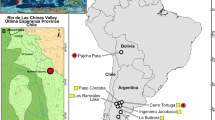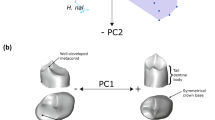Abstract
The main groups of living mammals, marsupials and eutherians, are presumed to have diverged in the Early Cretaceous1, but their early history and biogeography are poorly understood. Dental remains have suggested that the eutherians may have originated in Asia2, spreading to North America in the Late Cretaceous, where an endemic radiation of marsupials was already well underway3. Here I describe a new tribosphenic mammal (a mammal with lower molar heels that are three-cusped and basined) from the Early Cretaceous of North America, based on an unusually complete specimen. The new taxon bears characteristics (molarized last premolar, reduction to three molars) otherwise known only for Eutheria among the tribosphenic mammals. Morphometric analysis and character comparisons show, however, that its molar structure is primitive (and thus phylogenetically uninformative), emphasizing the need for caution in interpretation of isolated teeth. The new mammal is approximately contemporaneous with the oldest known Eutheria from Asia. If it is a eutherian, as is indicated by the available evidence, then this group was far more widely distributed in the Early Cretaceous than previously appreciated. An early presence of Eutheria in North America offers a potential source for the continent's Late Cretaceous radiations, which have, in part, proven difficult to relate to contemporary taxa in Asia.
This is a preview of subscription content, access via your institution
Access options
Subscribe to this journal
Receive 51 print issues and online access
$199.00 per year
only $3.90 per issue
Buy this article
- Purchase on Springer Link
- Instant access to full article PDF
Prices may be subject to local taxes which are calculated during checkout



Similar content being viewed by others
References
Lillegraven,J. A., Thompson,S. D., McNab,B. K. & Patton,J. L. The origin of eutherian mammals. Biol. J. Linn. Soc. 32, 281–336 (1987).
Butler,P. M. in Structure, Function and Evolution of Teeth (eds Smith, P. & Tchernov, E.) 125–138 (Freund, Tel Aviv, 1990).
Kielan-Jaworowska,Z. in Palaeontology, Essential of Historical Geology (ed. Gallitelli, E. M.) 367–383 (S.T.E.M. Mucci, Modena, 1982).
Nessov,L. A., Archibald,J. D. & Kielan-Jaworowska,Z. Ungulate-like mammals from the Late Cretaceous of Uzbekistan and a phylogenetic analysis of Ungulatomorpha. Bull. Carnegie Mus. Nat. Hist. 34, 40–88 (1998).
Ostrom,J. H. Stratigraphy and paleontology of the Cloverly Formation (Lower Cretaceous) of the Bighorn Basin area, Montana and Wyoming. Bull. Peabody Mus. Nat. Hist. 35, 1–234 (1970).
Cifelli,R. L. & de Muizon,C. Definition and jaw of Kokopellia juddi, a primitive marsupial or near marsupial from the medial Cretaceous of Utah. J. Mamm. Evol. 4, 241–258 (1997).
Butler,P. M. A new interpretation of the mammalian teeth of triposphenic pattern from the Albian of Texas. Breviora 446, 1–27 (1978).
Kielan-Jaworowska,Z. & Dashzeveg,D. Eutherian mammals from the Early Cretaceous of Mongolia. Zool. Scripta 18, 347–355 (1989).
Novacek,M. J. The skull of leptictid insectivorans and the higher-level classification of eutherian mammals. Bull. Am. Mus. Nat. Hist. 183, 1–112 (1986).
Sigogneau-Russell,D., Dashzeveg,D. & Russell,D. E. Further data on Prokennalestes (Mammalia, Eutheria inc. sed.) from the Early Cretaceous of Mongolia. Zool. Scripta 21, 205–209 (1992).
Butler,P. M. Early trends in the evolution of tribosphenic molars. Biol. Rev. 65, 529–552 (1990).
Clemens, W. A. Jr & Lillegraven,J. A. New Late Cretaceous, North American advanced therian mammals that fit neither the marsupial nor eutherian molds. Contrib. Geol. Univ. Wyoming 3, 55–85 (1986).
Lillegraven,J. A., Kielan-Jaworowska,Z. & Clemens, W. A. Jr (eds) Mesozoic Mammals—the First Two-thirds of Mammalian History (Univ. of California Press, Berkeley, 1979).
Dashzeveg,D. & Kielan-Jaworowska,Z. The lower jaw of an aegialodontid mammal from the Early Cretaceous of Mongolia. Zool. J. Linn. Soc. 82, 217–227 (1984).
Rougier,G. W., Wible,J. R. & Novacek,M. J. Implications of Deltatheridium specimens for early marsupial history. Nature 396, 459–463 (1998).
Nessov,L. A., Sigogneau-Russell,D. & Russell,D. E. A survey of Cretaceous tribosphenic mammals from middle Asia (Uzbekistan, Kazakhstan and Tajikistan), of their geological setting, age and faunal environment. Palaeovert. 23, 51–92 (1994).
Slaughter,B. H. Mid-Cretaceous (Albian) therians of the Butler Farm local fauna, Texas. Zool. J. Linn. Soc. 50 (suppl.), 131–143 (1971).
Wang,Y. Q., Hu, Y.-M., Chow, M.-C. & Li, C.-K. in Sixth Symposium on Mesozoic Terrestrial Ecosystems (eds Sun, A.-L. & Wang, Y.-Q.) 221–228 (China Ocean, Beijing, 1995).
Fox,R. C. Paranyctoides maleficus (new species), an early eutherian mammal from the Cretaceous of Alberta. Spec. Publ. Carnegie Mus. Nat. Hist. 9, 9–20 (1984).
Cifelli,R. L. et al. in Vertebrate Fossils of Utah (ed. Gillette, D. D.) 219–242 (Utah Geological Survey, Salt Lake City, 1999).
Jenkins, F. A. Jr & Schaff,C. R. The Early Cretaceous mammal Gobiconodon (Mammalia, Triconodonta) from the Cloverly Formation in Montana. J. Vert. Paleontol. 8, 1–24 (1988).
Kielan-Jaworowska,Z. Evolution of the therian mammals in the Late Cretaceous of Asia. Part II. Postcranial skeleton in Kennalestes and Asioryctes. Palaeontol. Pol. 37, 65–83 (1974).
Luo,Z. in In the Shadow of the Dinosaurs—Early Mesozoic Tetrapods (eds Fraser, N. C. & Sues, H.-D.) 98–128 (Cambridge Univ. Press, Cambridge, 1994).
Luckett,W. P. in Mammal Phylogeny, volume 2—Mesozoic Differentiation, Multituberculates, Monotremes, Early Therians, and Marsupials (eds Szalay, F. S., Novacek, M. J. & McKenna, M. C.) 182–204 (Springer, New York, 1993).
Acknowledgements
I thank W. D. Maxwell and D. Smith for their collaboration in field activities, S. K. Madsen for fossil preparation, N. J. Czaplewski for illustration, M. Kyte for cooperation of the US BLM, W. Helmer and C. Nomee for the cooperation of the Crow Tribe, and P. Butler for various help. Funding was provided by the National Geographic Society and the NSF.
Author information
Authors and Affiliations
Supplementary information
Rights and permissions
About this article
Cite this article
Cifelli, R. Tribosphenic mammal from the North American Early Cretaceous. Nature 401, 363–366 (1999). https://doi.org/10.1038/43860
Received:
Accepted:
Issue Date:
DOI: https://doi.org/10.1038/43860
This article is cited by
-
Middle ear innovation in Early Cretaceous eutherian mammals
Nature Communications (2023)
Comments
By submitting a comment you agree to abide by our Terms and Community Guidelines. If you find something abusive or that does not comply with our terms or guidelines please flag it as inappropriate.



